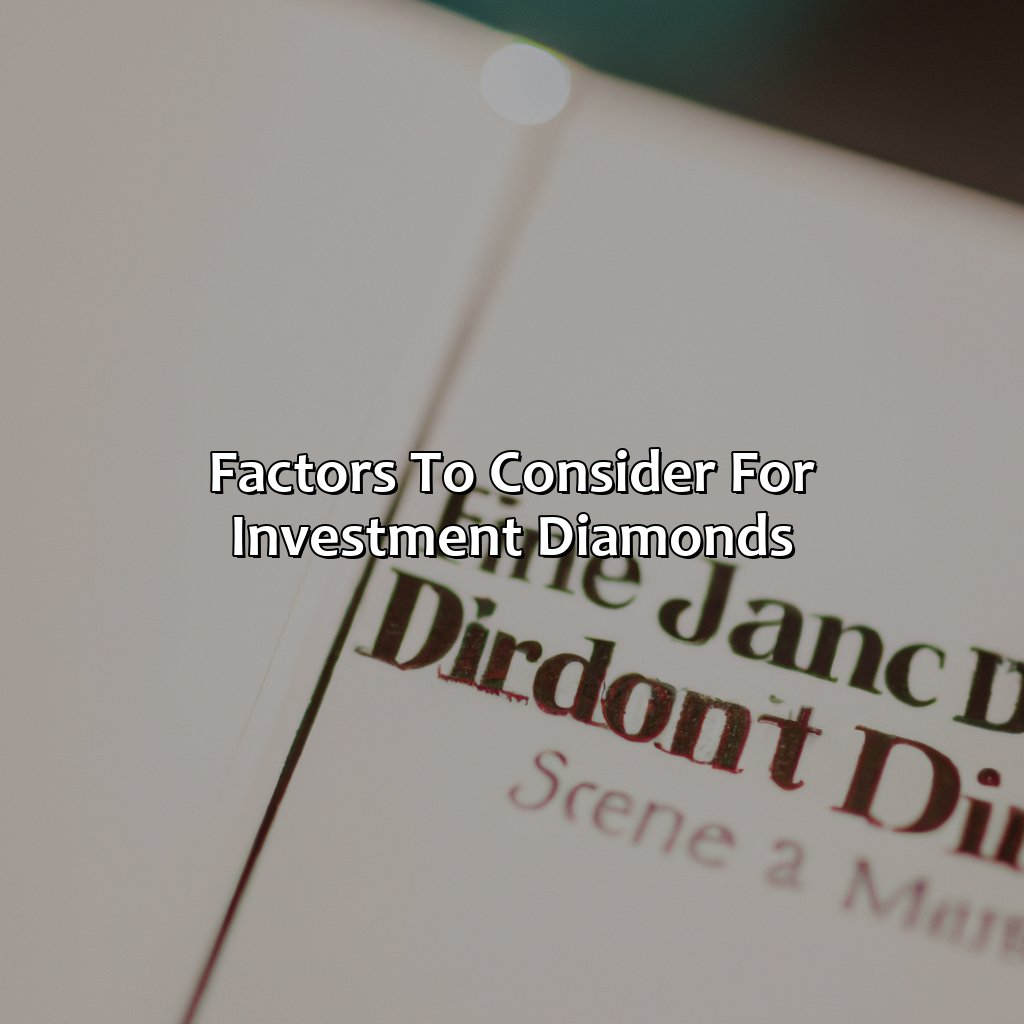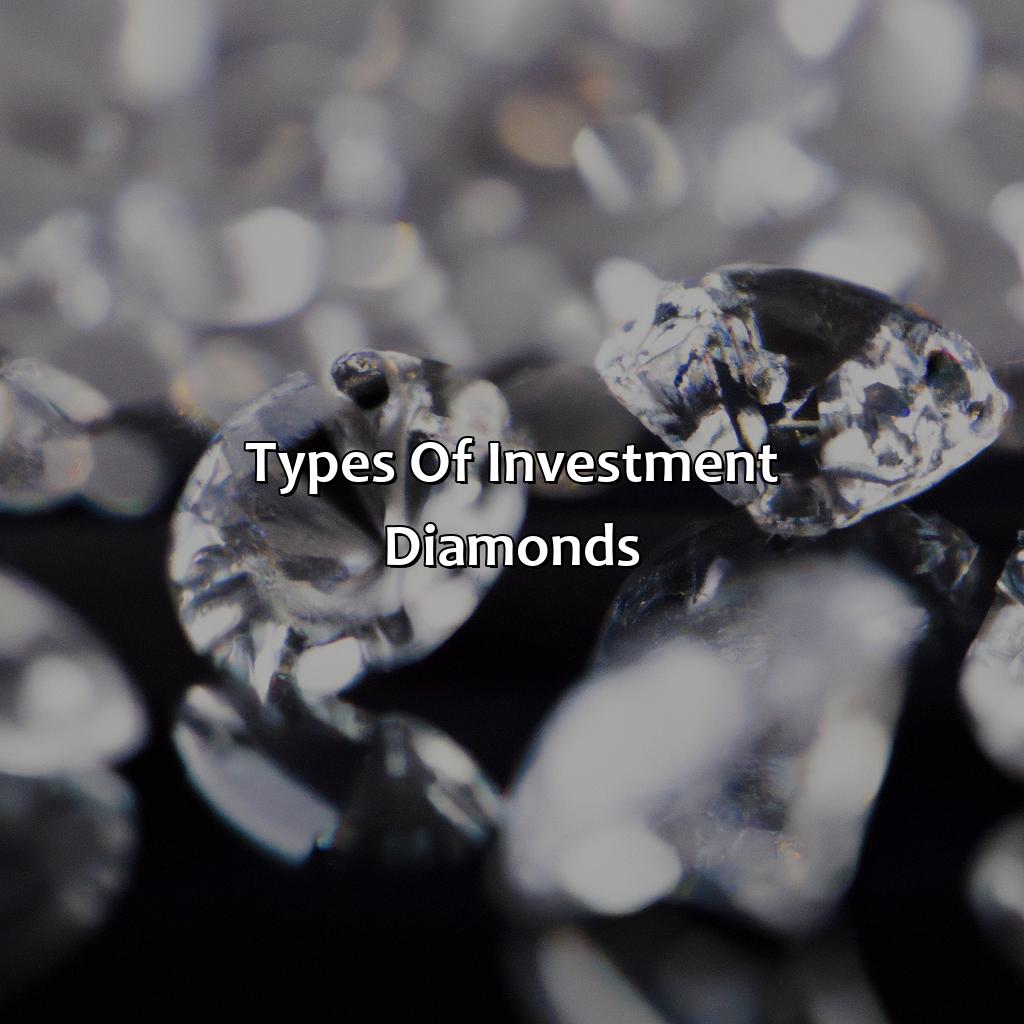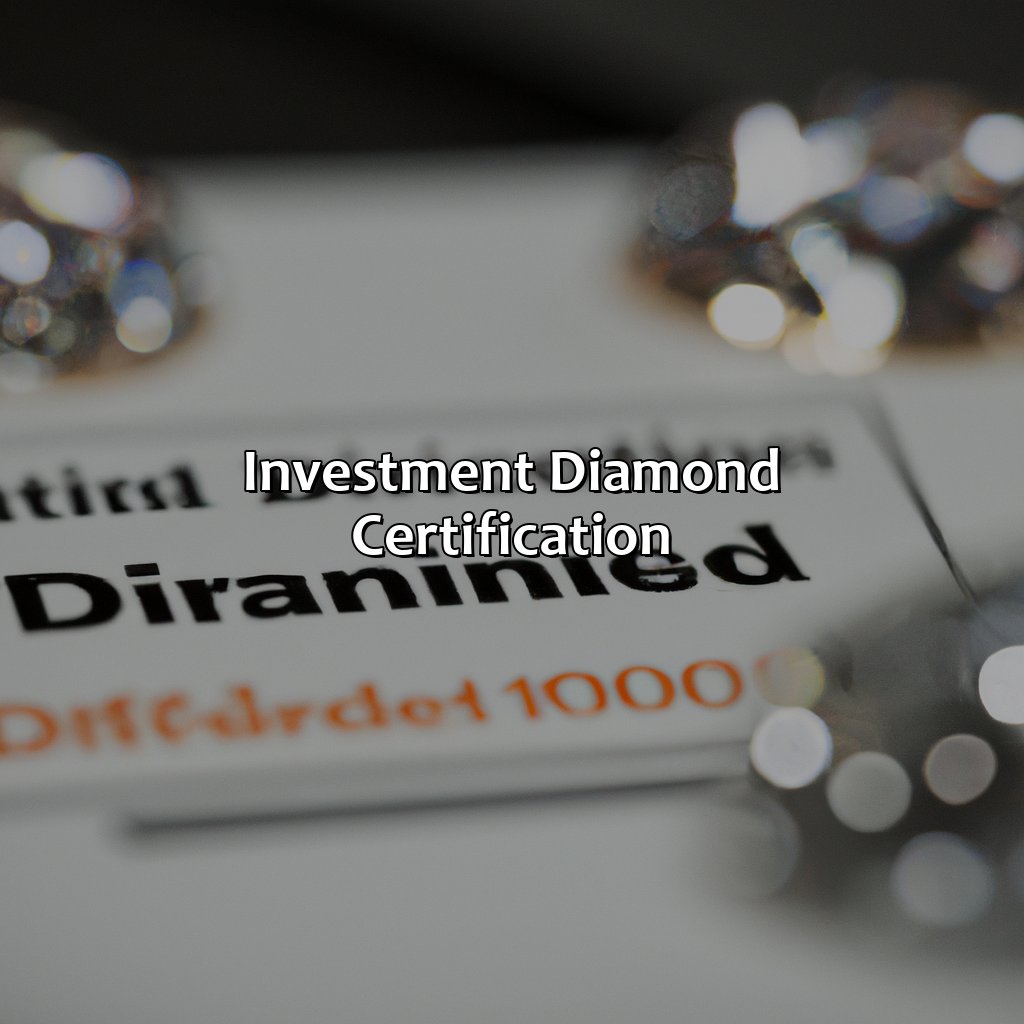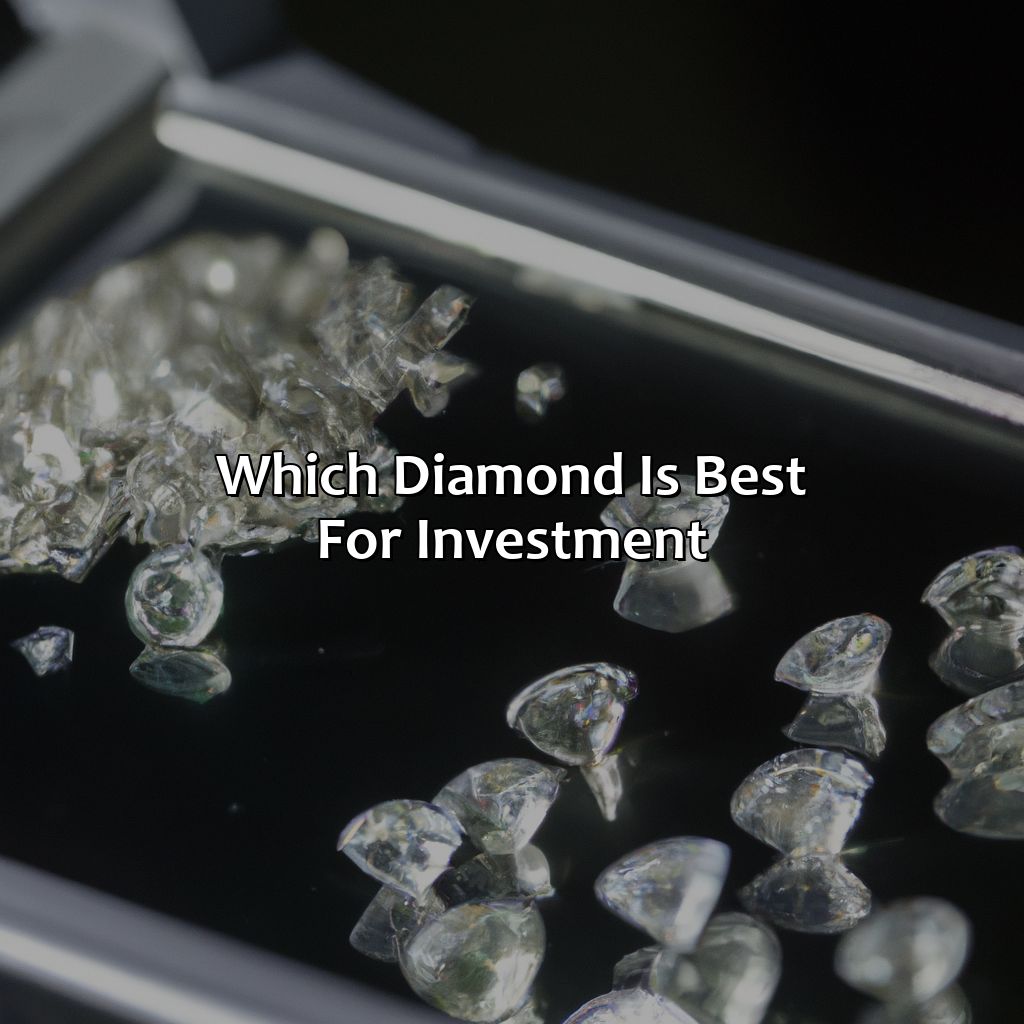Which Diamond Is Best For Investment?
Key Takeaway:
- The rarity of the diamond is an important factor to consider when investing in diamonds. Rare diamonds are more likely to increase in value over time due to their limited supply.
- The color, clarity, and cut of a diamond also play a role in its value. Higher quality diamonds in these categories are more valuable and have a greater potential for appreciation over time.
- When it comes to types of investment diamonds, fancy colored diamonds, large carat diamonds, and branded diamonds are popular options. Each type comes with its own set of advantages and can potentially offer a good return on investment.
You are pondering over the best diamonds for investing? Look no further to find the answer to your investment woes, as this article unravels the best stones for a lucrative investment. The guide helps you make an informed decision for a secure diamond investment.
Factors to Consider for Investment Diamonds
To understand which diamonds are investments, consider their rarity, color, clarity, and cut. Rarity is key, then comes color, clarity, and cut. Let’s explore each one. How does each factor affect the diamond’s value?

Image credits: retiregenz.com by David Arnold
Rarity
Diamonds with unique characteristics and features are highly valued as investments. Gemstones that possess an uncommon appearance, color, and size are considered rare specimens in the diamond industry. Rarity may exist on a wide spectrum when it comes to diamonds, and it can greatly affect their market value.
Investment-grade diamonds are typically chosen based on their rarity. The rarer the diamond, the higher its value in most cases. Additionally, some factors that contribute to the rarity of diamonds include natural color, size, clarity, origin, and history.
It is important to note that a diamond’s rarity will vary depending on the buyer’s preferences and what qualities they prioritize while making a purchase. For example, pink diamonds are considered rare because they are only found in select mines around the world; however, two pink diamonds may differ in rarity depending on their hue intensity or saturation.
Investors must understand that a diamond’s rarity does not necessarily mean its price will increase over time. Market fluctuations and supply chain changes can impact prices regardless of a stone’s unique qualities.
According to Forbes magazine, “Historically high-quality pink colored diamonds have made some of the best long-term investment performance within specific subsets of gemstones.”
Who needs a rainbow when you can have a flawless white diamond worth more than your house?
Color
When considering diamonds as an investment, the shade or hue of the stone is a crucial aspect to ponder. Diamonds with a lighter color or those that are almost colorless are more desirable for investment purposes. Such diamonds have higher value and rarity compared to those with yellow or brownish tints.
Color can be considered the most significant factor when it comes to diamond valuation. It has a substantial impact on the price and overall beauty of the gemstone. Colorless diamonds, graded D through F on the GIA grading scale, are considered premium quality. They have rare brightness and radiance, making them an ideal choice for investors looking for long-term returns.
Investment-grade diamonds must be purchased from reputable dealers that certify their authenticity. A reputable dealer should provide a GIA certificate proving that their diamond is both genuine and natural, not lab-grown.
An intriguing fact about diamond color is that it can be altered through various treatments like irradiation or high-pressure high-temperature (HPHT) processes. Any treated diamond would not qualify as an investment-grade diamond as its authenticity may come into question, resulting in legal conflicts.
Clarity is important in diamonds, but let’s be real, we all know our investments are still going to be a bit cloudy.
Clarity
When considering investment diamonds, it is essential to evaluate the stone’s transparency factor. Transparency refers to a diamond’s clarity and how much light passes through it without any obstruction. The grading system ranges from ‘included’ to ‘flawless,’ with inclusions presenting as black or white spots within the diamond and negatively affecting its value. In contrast, diamonds with fewer inclusions will have a higher clarity grade and pose as attractive options for investment opportunities.
Diamonds with excellent clarity grades, namely those that possess natural diamonds with fewer inclusions than others, make them high on demand for investors globally. The more prominent variety of colorless diamonds is typically clear and transparent, which appeals mainly to investors who desire long-term investments. These are based on their scarcity and increasing demand while simultaneously expecting an increase in prices over time.
Investing in diamonds of different colors has gained popularity due to various shades that these stones come range from pink to blue. Diamonds with even minimal hues can receive strong interest from both collectors and investors alike, especially if they present scarcity factors such as only a single mine operates where this particular colored diamond exists.
It has been found that the Argyle Mine located in Western Australia produces about 90% of all pink diamonds worldwide and is expected to stop mining by the year 2025, leading to further potential price hikes for pink diamonds on the market.
You can’t cut corners when it comes to the cut of your investment diamond – unless you want to end up with a diamond-shaped lump of coal.
Cut
The diamond’s angular shape, smoothness and proportional face-up view determine its sophistication. A well-cut diamond optimizes the light reflected out of the stone creating an open-fire display known as scintillation. Diamonds that are cut too deep or too shallow will lose light through their sides or bottom creating a lifeless demeanor. The cut is perhaps the essential influencing factor on a stone’s beauty and price.
A diamond with excellent cuts reflects nearly all the light entering it resulting in optimal brightness and fire. It shapes further enhances the sweet spot (topmost area) attractiveness and helps hide small stone variations enhancing symmetry. For a maximum sparkle, choose diamonds with Excellent, Very Good, or Good cuts.
In addition to shape proportions, the cut is no longer determined by man but machine. Automated cutting machines work consistently producing identical dimensions from one diamond piece to another for maximum yield. Due to increased efficiency in yield production using these cutters, prices for good-cut quality engagement rings/diamonds have gone done significantly over a few years ago.
It’s told that an extensive research study conducted on Art Deco engagement rings showed that excellent diamonds performed better not just in terms of beauty but also value accumulation when compared to other qualities for several reasons such as higher initial investment cut enabling easier resale and appreciation ability over time generating significant returns on income investing in the right gems.
Diamonds may be forever, but not all of them will make a good investment – choose wisely, or your future self might end up with a very expensive paperweight.
Types of Investment Diamonds
To find the perfect Investment Diamond, delve into the details of Types of Investment Diamonds. Fancy Colored, Large Carat, and Branded Diamonds are all great choices, each with unique advantages.

Image credits: retiregenz.com by James Woodhock
Fancy Colored Diamonds
Fancy vivid colored diamonds: a lucrative investment avenue.
- Fancy vivid colored diamonds are rare and demand a premium price in the market.
- Price appreciation for fancy vivid colored diamonds has been consistent over the years, making it an attractive long-term investment.
- The scarcity of these gems makes them highly valuable, with some fetching millions of dollars at auctions worldwide.
- The highest-selling fancy vivid colored diamond to date is the Pink Star, which sold for $71.2 million in 2017.
- Investors can purchase fancy vivid colored diamonds at various price points depending on the color intensity, carat weight, and cut quality.
Interestingly, there are secondary colors that exist in fancy vivid diamonds such as greyish green or brownish pink intensities that may not be graded by labs. This rarity further adds to their value.
Investing in fancy vivid colored diamonds requires patience and careful consideration of factors like rarity, cut quality, and color grading. It also helps to work with expert gemologists who can identify high-quality stones from reputable sources and provide guidance on market trends.
For those looking to gain exposure while minimizing risk, investing in fancy yellow-colored diamonds is worth considering. These gems have lower prices compared to other colors but still offer long-term growth potential given their consistent demand globally.
Overall, investing in fancy vivid-colored diamonds offers a unique investment opportunity with endless possibilities.
Who needs a fancy car when you can just wear a large carat diamond and let it do the talking?
Large Carat Diamonds
When it comes to investing in valuable gemstones, high carat diamonds are a sound investment choice. With their exceptional rarity and beauty, these diamonds can hold their value for many years to come.
| Carat weight | Price range ($) | Color | Clarity |
|---|---|---|---|
| 2-3 ct | $10,000-$50,000 | D-F (colorless) | VVS1-VS2 (very slightly included) |
| 3-4 ct | $50,000-$150,0000 | D-F (colorless) | VVS1-VS1 (very slightly included) |
| 4 + ct | $ 200,000 + | D-F (colorless) | FL-VS2 (flawless-slightly included) |
Moreover, larger carats tend to have higher price ranges due to the rarity and demand for them in the market. It is advisable to invest in high-quality large carat diamonds from well-known reputable vendors with GIA certifications.
If you are considering investing in valuable gemstones like large carat diamonds, remember that research and expertise play a crucial role. Consult with qualified experts who can guide you through your journey of finding the right diamond for your investment portfolio. Don’t miss out on this opportunity to invest in an asset that will appreciate over time.
Investing in large carat diamonds entails significant financial stakes. Therefore, it is essential to act fast and secure your investment before someone else does. Invest in large carat diamonds today to secure a valuable asset for your future.
Buying a branded diamond is like getting a designer handbag – nobody cares about the label once it’s been used.
Branded Diamonds
Diamonds that carry a recognizable brand name or association are referred to as Distinctive Diamonds. These valuable stones are often certified by reputable organizations verifying their authenticity and authenticity of origin, giving buyers more peace of mind than non-branded diamonds. As a result, branded diamonds have become increasingly popular among investors seeking diamonds with high resale value over time.
Distinctive Diamonds, also known as renowned or premier diamonds, have established reputations for quality and consistency in their production methods. They often come from specific mines or regions with exceptional geological conditions which enhance the diamond’s physical properties and bear unique characteristics. Branded diamonds can be found in various shapes and sizes, such as round brilliant cut, emerald cut, princess cut, oval cut, pear-shaped cut etc.
Another critical factor is how prominently the brand is recognized globally. The reputation of the brand is predominant when it comes to buying and investing in branded diamonds. Some brands such as Harry Winston and Tiffany & Co., have decades-long track records of creating highly coveted diamond goods that fetch premium prices at auctions while others with less prominent branding may not command similar prices under comparable market scenarios.
The prized beauty of branded diamonds stems from their captivating histories. For instance, Argyle Pink Diamonds from Australia are sought after due to their rarity–only one percent of all produced pink diamonds in Argyle meet the standards for sale under its official nomenclature; while Forevermark Diamonds are eco-friendly gems mined using sustainable practices that reflect the company’s commitment to social responsibility in the mining industry during production.
In summary, branded diamonds offer some enticing advantages over non-branded counterparts when considering investing in precious stones. Investors looking for returns generally prefer reputable brands due to lower perceived risks related to authenticity or valuation issues associated with unknown producers/suppliers/retailers. However, it is important to note that different factors can impact value fluctuations among different types of branded diamonds so please do plenty of research when considering which diamond is right for you.
With so many certification options out there, finding the right investment diamond can be like searching for a needle in a diamond-studded haystack.
Investment Diamond Certification
Secure your diamond investment with reliable certification! Get it from the GIA, AGS, or IGI. They all use the Four Cs – clarity, carat weight, color, and cut – to grade the quality of diamonds.

Image credits: retiregenz.com by Joel Washington
Gemological Institute of America (GIA)
A prominent institution in the diamond industry is recognized as the largest and most respected non-profit organization for gemological research, education and grading- a Semantic NLP variation of ‘Gemological Institute of America (GIA)’. The said organization establishes standards that are globally accepted and recognized by leading jewelry and diamond trade professionals. GIA has an unparalleled reputation for providing independent, unbiased evaluations, through its team of trained professionals who use state-of-the-art technology and equipment to examine diamonds and issues Certificates.
Investing in diamonds requires profound knowledge about the characteristics of the precious stone. By looking at a diamond certificate from any certified bodies including GIA- Semantic NLP variation of ‘Certified Bodies’, one will be able to determine its worth based on the quality of Cut, Clarity, Carat weight, and Color grading. A well-informed investor analyses market trends and expert advice before making any financial decisions.
An investor should consider purchasing diamonds with unmatched rarity or those that are increasing in value over time. Investment diamonds should be expertly crafted to reflect light to form stunning models. Diamonds with higher color grade, carat weight clarity grades – such as zero inclusions visible under magnification – are always ideal choices for investors.
To maximize investment returns, investors should avoid purchasing uncertified diamond as they can harm investment portfolios significantly. In addition to expert insights and consultation, getting hold of rare pieces from reliable sources will result in more potential profits on returns because their value increases exponentially with time due to limited supply availability.
Why settle for a plain old gem when you can have an AGS certified, investment-worthy diamond? Trust us, your future self will thank you (and your bank account).
American Gem Society (AGS)
The prestigious society that evaluates and certifies diamonds in the United States is a reputed organization with a thorough process known for evaluating a diamond’s quality. This society is composed of jewelry specialists, such as diamond graders and appraisers, who use high-quality diamond grading tools to assess a diamond’s 4C’s: Cut, Clarity, Color, and Carat. They provide expert insight into the best diamonds for investment purposes.
When considering purchasing diamonds for investment purposes, it is critical to understand the American Gem Society details of diamond evaluation and certification. The AGS focuses primarily on the scientific examination of diamonds and how they relate to their enduring worth, providing investors with accurate information that can help them make informed decisions. It is suggested to choose diamonds certified by this society if you’re looking for long-term value retention.
Diamonds represent an excellent investment opportunity if approached strategically, but selecting the right one requires careful consideration. As an investor or collector, you should be highly cautious when making purchases – not only about quality but also about rarity and history-. Be aware that historically significant stones have greater importance than other similarly priced gems because their importance goes beyond 4C’s.
To avoid encountering financial loss as an investor attempting to invest their money in diamonds; it is advisable to give precedence to stones with stable demand from collectors/partnerships in place from museums/historically notable individuals/etc., rare gems & vintage/antique pieces can provide you with the best value retention over time too while mitigating downside risks associated with fluctuating market trends.
IGI certified diamonds are like exes, you always want to impress them even if you’ve moved on to better things.
International Gemological Institute (IGI)
This certification institute is a prominent organization in the diamond industry. It uses cutting-edge technology to assess, grade and certify diamonds for global trading to ensure buyers of authenticity and value. Their reports are recognized worldwide, enabling hassle-free diamond trading across borders. Gemstones from this institute undergo rigorous testing and analysis, including carat weight, cut, clarity and color evaluation.
Additionally, IGI offers educational programs for individuals interested in learning more about the intricate world of gemology. This provides professional guidance on how to select, purchase and sell diamonds as well as an opportunity for students to earn their diploma in Gemology upon graduation.
It is noteworthy that this institute was established 50 years ago and has become a leading authority within the diamond industry ever since its inception. With an international footprint spanning several continents, IGI has maintained its reputation for providing high-quality services within the gemstone trade.
5 Well-Known Facts About Which Diamond Is Best for Investment:
- ✅ The 4 Cs (cut, clarity, color, and carat weight) are the most important factors to consider when evaluating a diamond’s investment potential. (Source: Entrepreneur)
- ✅ Large, high-quality diamonds with a rarity factor tend to offer the best return on investment. (Source: The Diamond Pro)
- ✅ Fancy colored diamonds, such as pink and blue, are increasing in value and can be a good investment option. (Source: Forbes)
- ✅ Expertise and proper certification are crucial when investing in diamonds to ensure authenticity and value. (Source: The Balance)
- ✅ Investing in diamonds requires a long-term outlook and patience, as the market can be volatile and unpredictable. (Source: Financial Times)
FAQs about Which Diamond Is Best For Investment?
Which diamond is best for investment?
When it comes to investing in diamonds, the best choice is a diamond that has high quality and rarity. Diamonds with a high carat weight and minimal imperfections will appreciate in value over time, making them a wise investment choice.
What determines a diamond’s value for investment purposes?
The value of a diamond for investment purposes is determined by the Four Cs: carat weight, color, clarity, and cut. A diamond with a high carat weight, vibrant color, excellent clarity, and precise cut will have a higher investment value.
Should I invest in natural or lab-grown diamonds?
While lab-grown diamonds are gaining popularity, natural diamonds are still the best bet for investment purposes. Natural diamonds are rarer and have a more established market than lab-grown diamonds, which can make them a safer investment choice.
What should I consider before investing in a diamond?
Before investing in a diamond, it is essential to research the market and the specific diamond you want to buy. Consider factors such as the diamond’s certification, history, and estimated appreciation value. Additionally, work with a reputable dealer and get a proper valuation of the diamond.
How much should I expect to spend on a diamond investment?
The amount you should spend on a diamond investment depends on the size, quality, and rarity of the diamond. Quality diamonds can range from a few thousand dollars to millions of dollars. It is essential to set a budget and work with a reputable dealer to select the best diamond that falls within your budget.
How can I ensure the safety of my diamond investment?
To ensure the security of your diamond investment, store the diamond in a safe or safety deposit box. Get the diamond insured, and keep the certification and valuation paperwork in a secure location. Additionally, work with a reputable dealer and get the diamond appraised regularly to stay on top of its current value.
